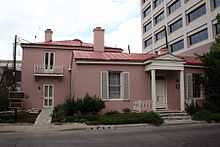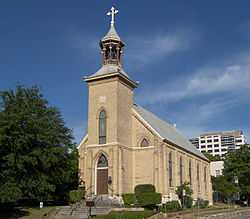Texas Historical Commission
|
Texas Historical Commission seal | |
|
Texas Historical Commission logo | |
| Agency overview | |
|---|---|
| Formed | 1953 |
| Headquarters | Austin, Texas |
| Employees | 175 |
| Website |
www |

The Texas Historical Commission is an agency dedicated to historic preservation within the state of Texas. It administers the National Register of Historic Places for sites in Texas.
The commission also identifies Recorded Texas Historic Landmarks and recognizes them with Official Texas Historical Marker medallions and descriptive plaques. Finally, the commission identifies State Archeological Landmarks and Historic Texas Cemeteries. A bimonthly publication, The Medallion, is published by the agency as a state-wide preservation newsletter and they maintain the Texas Historic Sites Atlas web site to help people locate historic sites.
The commission has main offices in the Capitol Complex in downtown Austin; the complex includes the Carrington-Covert House, Luther Hall, Gethsemane Lutheran Church, Elrose Building, and the Christianson-Leberman Building.
History of the Commission
Established in 1953, The Texas State Legislature created a State Historical Survey Committee with the task to identify important historic sites across the state. The Texas Legislature changed the agency's name to the Texas Historical Commission in 1973.
From 1963-1967, former state Attorney General John Ben Shepperd headed the commission and moved to expand the number of state highway markers to promote historic preservation.[1]
Personnel
Today, the agency employs about 100 personnel. The Texas Historical Commission leadership is composed of 18 members appointed by the Governor with the advice and consent of the Senate, serving overlapping six-year terms. All members must be citizens of Texas, and together represent all geographical areas of Texas.
The commission also employs personnel in various fields, including archeology, architecture, economic development, heritage tourism, history, public administration and urban planning. These personnel consult with citizens and organizations to preserve Texas's architectural, archeological and cultural landmarks.
In the late 1990s, the agency was restructured to have seven divisions that carry out the responsibilities of the agency. The divisions are:
- Administration Division
- Staff Services Division
- Archeology Division
- Division of Architecture
- History Programs Division
- Community Heritage Division
- Marketing Communications Division
There are several boards associated with the Texas Historical Commission:
- The State Board of Review
- The Antiquities Advisory Board
- The Guardians of Texas Preservation Trust Fund
- The Advisory Board of the Texas Preservation Trust Fund
- The Main Street Interagency Council
Texas Heritage Trails Program
The Texas Historical Commission administers this state-wide heritage tourism program.[2] This program is historically based in the ten 650-mile circular driving regions that Texas Department of Transportation and Gov. John Connally designated in 1968 in connection with the World's fair in San Antonio, Texas, called HemisFair '68. After the fair, these trails were all but forgotten. The Texas Historical Commission began its program based on these historical designations in 1998, starting with the Texas Forts Trail.[3] and was completed in 2005 with the addition of the Texas Hill Country Trail and the Texas Pecos Trail. The goals of the program are to promote heritage tourism and historic preservation.
The state of Texas is divided up into ten heritage regions:
- Texas Brazos Trail[4]
- Texas Forest Trail
- Texas Forts Trail
- Texas Hill Country Trail
- Texas Independence Trail
- Texas Lakes Trail
- Texas Mountain Trail
- Texas Pecos Trail
- Texas Plains Trail[5]
- Texas Tropical Trail
In 2005 the Heritage Trails Program won the Preserve America Presidential award for exemplary accomplishment in the preservation and sustainable use of America's heritage assets, which has enhanced community life while honoring the Nation's history.[6]
Historical Markers

Sponsors may apply for official historical markers through their county historical commissions. The purpose of the markers, which are available in a variety of types (cemetery, building, subject) and sizes, is to educate the public. An application must meet certain requirements to be approved by the THC commissioners as qualifying for a marker.
Beginning in November 2006, the Texas Historical Commission adopted a new marker program. The following are some of the major changes to the program:
- All applications are to be submitted electronically
- There is now an annual application deadline
- An application fee is required
- The inscription process has been reworked
As of 2007, there are over 13,000 Official Texas Historical Markers placed throughout the state. Texas has the most prolific state historical marker program in the United States.[7]
One of the devotees of the expanded historical marker program was Rupert N. Richardson, the Texas historian who served as a THC member from 1953–1967 and was from 1943-1953 the president of Hardin-Simmons University in Abilene.[8]
Recorded Texas Historic Landmark
Recorded Texas Historic Landmark is the highest designation given by the Texas Historic Commission for significant structures in Texas.
Headquarters complex
The commission has main offices in the Austin Complex in downtown Austin; the complex includes the Carrington-Covert House at 1511 Colorado Street, Luther Hall, Gethsemane Lutheran Church, Elrose Building, and the Christianson-Leberman Building.[9][10]
The Carrington-Covert House was turned over to the commission to serve as the agency's headquarters in 1971. Gethsemane Lutheran Church was restored to serve as offices of the agency in 1970 and 1971.[11]
See also
- List of National Historic Landmarks in Texas
- National Register of Historic Places listings in Texas
- T. R. Fehrenbach Award
Notes
- ↑ "George E. Christian, "John Ben Shepperd", The Handbook of Texas". tshaonline.org. Retrieved July 21, 2009.
- ↑ Karimi, Sabah. "Heritage Tourism in Texas". USA Today. Retrieved 5 December 2013.
- ↑ Bluthardt, Bob (21 September 2012). "Trail offers more than forts". San Angelo Standard-Times. Retrieved 5 December 2013.
- ↑ "Brazos Trail Region to begin work as next Heritage Trail". Temple Daily Telegram. 5 September 2002. Retrieved 5 December 2013.
- ↑ Reynolds, John (13 August 2003). "Texas Plains Trail designated state's newest heritage trail". Lubbock Avalanche-Journal. Retrieved 5 December 2013.
- ↑ Milhans, Bruce. "ACHP announces 2009 Preserve America Presidential Awards". Preserve America. preserveamerica.gov. Retrieved 5 December 2013.
- ↑ , Marker & Designation Frequently Asked Questions, Texas Historical Commission. Retrieved July 3, 2007.
- ↑ "Mark Odintz, "Rupert N. Richardson", The Handbook of Texas". tshaonline.org. Retrieved October 10, 2009.
- ↑ "Texas Historical Commission Austin Complex." Texas Historical Commission. Retrieved on March 6, 2009.
- ↑ "Contact Us." Texas Historical Commission. Retrieved on March 6, 2009.
- ↑ "A 10K Walk Through German-Texas Heritage in Austin, Texas." The University of Texas at Austin. 3/6. Retrieved on November 15, 2009.
External links
| Wikimedia Commons has media related to Texas Historical Commission. |
| ||||||||||||||||||
| ||||||||||||||||||||||||||


